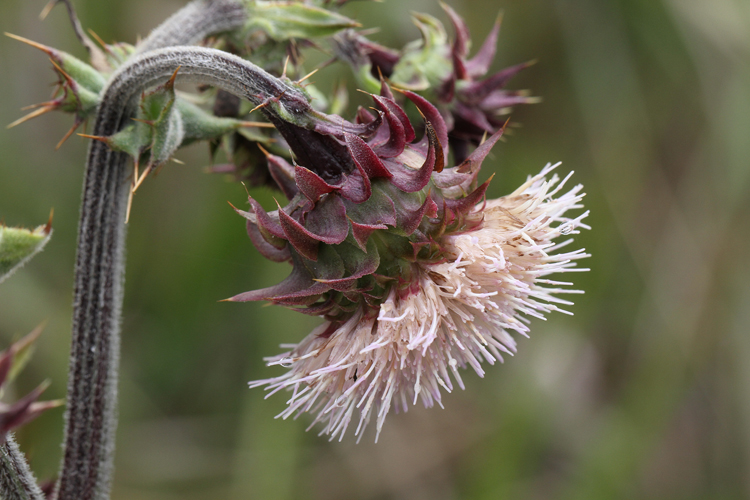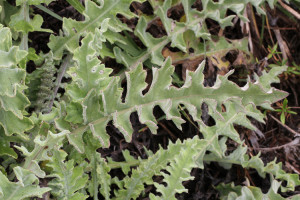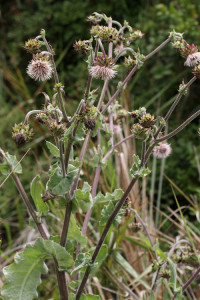Cirsium fontinale var. obispoense
- Endangered – Endangered Species Act (1994)
- Rare Plant Rank 1B.2 – California Native Plant Society
- T2 Imperiled – NatureServe (2013)

Image courtesy Lynn Robertson
The Los Padres is home to a wide diversity of plant species. One of the prickliest and rarest of these species is the San Luis Obispo fountain thistle (also known as the Chorro Creek bog thistle).
This thistle, a habitat specialist, can only grow in springs and stream banks with serpentine soils. These unique habitat requirements have made the plant quite rare and susceptible to extinction. It has only been found in ten different locations in San Luis Obispo County, with isolated localities in the Irish Hills, eastern Los Osos Valley (i.e., above Laguna Lake), and along the coastal front of the Santa Lucia Range between San Simeon Creek and Reservoir Canyon. None of these locations are on national forest lands, but they get quite close, suggesting that the plant might be found in the Los Padres National Forest.
The San Luis Obispo fountain thistle usually lives 2-3 years. During the first year the thistle forms a rosette of leaves, which can be up to 3 feet in diameter. The thistle then develops a flowering stalk which can reach heights of seven feet during its second year. This flowering stalk typically has numerous nodding flower heads, which flower between May and June. After flowering the plant usually dies unless enough energy has been stored to survive another year.

Image courtesy Lynn Robertson
Threats
The Chorro Creek Bog Thistle is primarily threatened by livestock trampling and grazing and water diversions. Cattle have been known to graze on the thistle and trample the seeps that they occupy. Trampling by cattle or other disturbances can leave these ecosystems vulnerable to invasion by exotic plant species that can outcompete native plants like the thistle.
Also, because of the fountain thistle’s small remaining populations and few suitable habitat sites, the thistle is susceptible to chance events like drought that could drive the species to extinction. As well, with most threatened and endangered species, the thistle is threatened by development and destruction of habitat.
Conservation
The San Luis Obispo fountain thistle was listed as a federally endangered species in 1994. The thistle is also listed as endangered by the state of California. However, there has been no designation of critical habitat as of yet.

Image courtesy Lynn Robertson
Since being listed in 1994, efforts have been taken to help protect the remaining populations of the fountain thistle. Many of the areas that house the remaining thistle populations have been protected from development and several areas have established grazing exclusions to prevent harm from cattle operations.
Future conservation efforts and the survival of the Chorro Creek Bog Thistle will depend on continuing research to gain better understanding of the habitat, hydrology, and pollination needs of this vulnerable, iconic, and prickly species. ForestWatch recommends that surveys are undertaken to determine whether this fountain thistle grows in the Los Padres National Forest and whether additional measures need to be taken to protect this habitat.






